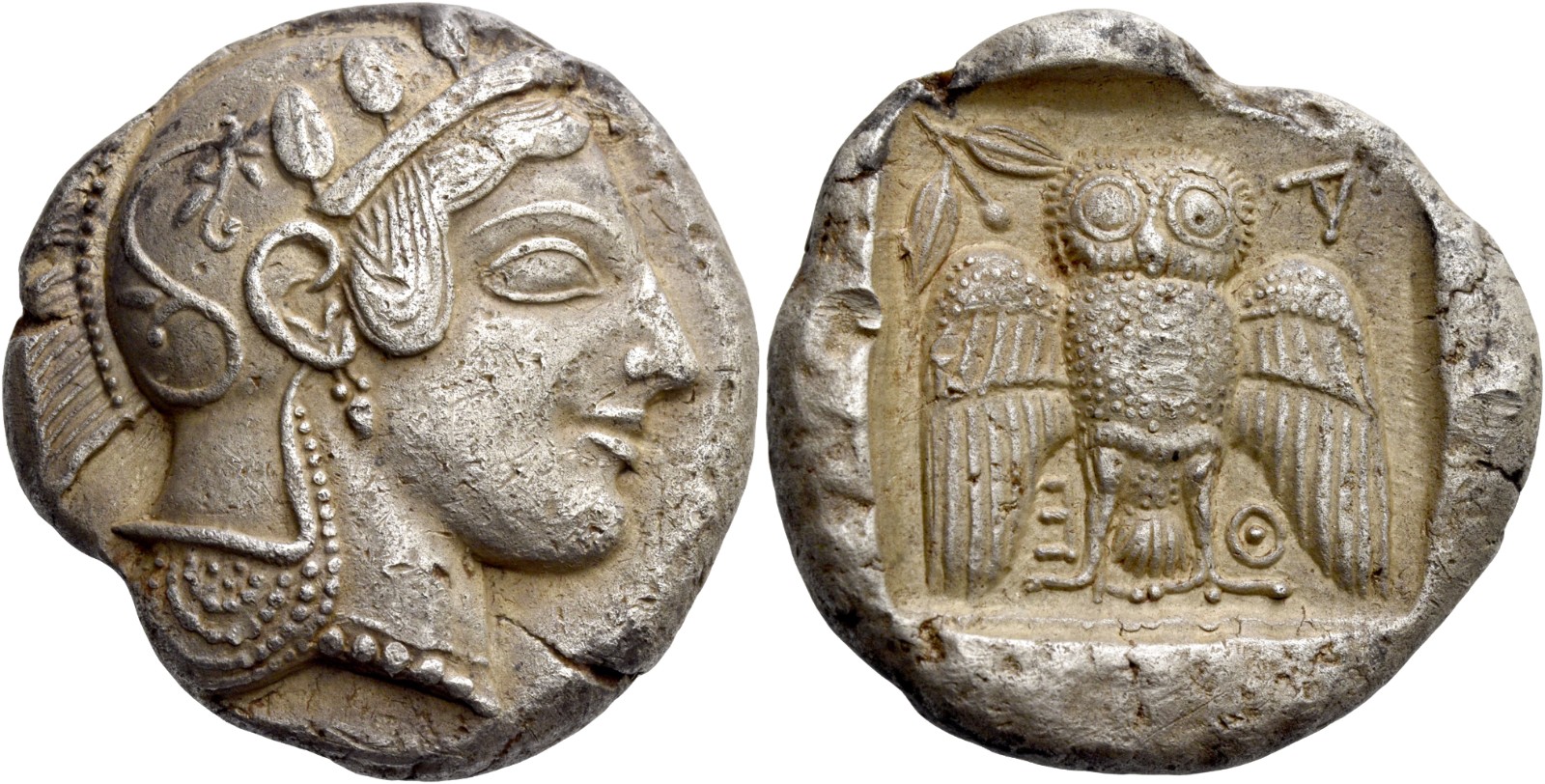Athens, silver, decadrachms (470-460 BCE) Starr
From SILVER
470 BCE - 460 BCE Silver 80,087 kg
Description
| ObverseInscription or printing placed on the obverse.: | Head of Athena r., wearing crested helmet, earring and necklace, bowl ornamented with spiral and three olive leaves. |
| ReverseInscription or printing placed on the reverse.: | AΘE (Greek).Owl standing facing, with spread wings, in upper l. field, olive sprig with two leaves and berry. The whole within incuse square |
Mint and issuing power
| MintIdentifies the place of manufacture or issue of a numismatic object.: | Athens | Ancient regionAncient region.: | Attica | Modern countryModern country: Greece | AuthorityIdentifies the issuing power. The authority can be "pretended" when the name or the portrait of X is on the coin but he/she was not the issuing power. It can also be "uncertain" when there is no mention of X on the coin but he/she was the issuing power according to the historical sources: |
Chronology
| FromIdentifies the initial date in a range assigned in a numismatic context. | 470 BCE | toIdentifies the final date in a range assigned in a numismatic context.. | 460 BCE | PeriodTime period of the numismatic object.: Classical 480-323 BC |
Physical description
| MetalThe physical material (usually metal) from which an object is made.: | Silver |
Median weightMedian of the weights of numismatic objects (in grams). in grams | 42.50 | DenominationTerm indicating the value of a numismatic object. Examples: tetradrachm, chalkous, denarius.: | decadrachm |
StandardStandard.: | Attic |
Image

AC192 Athens decadrachm.jpg [1]
References
| Die study referencePublication of the study: | Starr 19701Starr 1970, Group II.C, Fischer-Bossert 20082Fischer-Bossert 2008, n° 19c | ||
| Coin series referenceReference to coin series study: | Sear I3Sear I, n° 2516, RQEMAC4RQEMAC, n° 192, HGC 45HGC 4, n° 1585 | ||
| Coin series web referenceCoin series web references: | |||
Obverse dies distribution
Reverse dies distribution
no distribution is available
Quantification
| Number of obversesNumber of obverse dies. ᵖ (o) | 11 | Number of singletons (o1)The number of singleton coins. ᵖ | 10 |
| Number of reverse diesNumber of reverse dies. (r) | 11 | Number of coinsNumber of coins. (n) | 12 |
| Coins per obverse dieNumber of coins per obverse die. (n/o) | 1.09 | Coins per reverse dieNumber of coins per reverse die. (n/r) | 1.09 |
| Reverse per obverse ratioRatio of obverse dies divided by reverse dies. (r/o) | 1 | Percentage of singletons (o1)number of coins (n) divided by the number of singletons (o1) ᵖ | 90.91 % |
| Original number of dies (O) (Carter 1983 formula)The estimation of the number of coins according to Carter 1983 ᵖ | 94.22 | Coins struck if 20,000 as average productivity per dieCoins made if the average productivity for obverses (according to Carter) is 20,000. ᵖ | 1,884,400 |
| Original number of dies (O) (Esty 2011 formula)The estimation of the number of coins according to the singleton formula in Esty 2011 ᵖ (O) | 132 | Survival rate if 20,000 as average productivity per dieSurvival rate if average productivity is 20,000. ᵖ | 0.00001 |
| Coverage (o = % of O) (Esty 1984 formula)Esty 1984 - coverage (% of O) ᵖ (o = % of O) | 16.67% | Die productivity if survival rate 1/2,000Average productivity if survival rate is 1/2,000. ᵖ | 254.72 |
| Weight of silver (in kg) if 20,000 coins per die (O = Carter formula)Carter 1983 * Median weight * 20000 (*10 if gold or electrum) ᵖ | 80,087 kg <br /> 80,087 kg | Die productivity if survival rate 1/5,000Average productivity if survival rate is 1/5,000. ᵖ | 636.81 |
Remarks